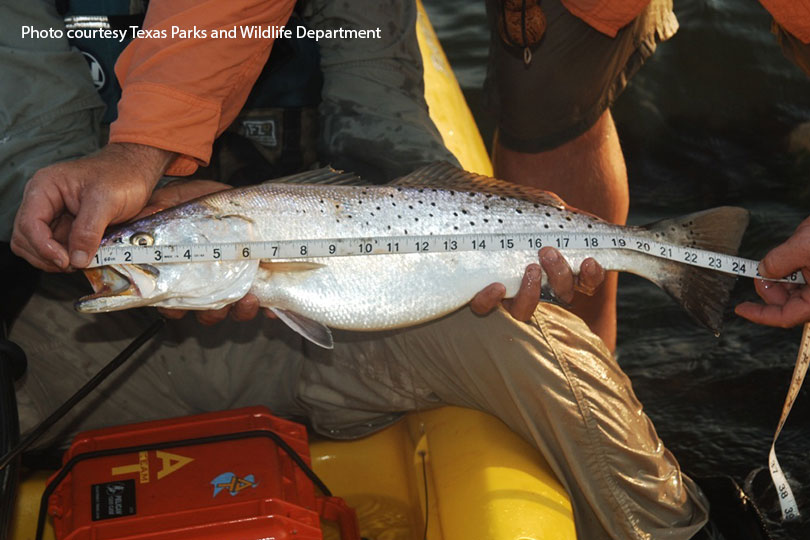By Jessica Domel
Multimedia Reporter
To support spotted seatrout populations as they continue to recover from a freeze in 2021, the Texas Parks and Wildlife Department (TPWD) is considering changes in the daily bag limit and size limit for the saltwater fish.
TPWD Coastal Fisheries staff are preparing the proposal approved by the Parks and Wildlife Commission moving the daily bag limit to three fish, 15-20 inches long, with an allowance for one trout longer than 25-inches as part of the daily bag.
Currently, anglers are able to keep five spotted, or speckled, seatrout per day, 15-25 inches long, with one fish over 25 inches.
Those regulations were re-instated after temporary restrictions, enacted after a freeze led to the deaths of more than a thousand seatrout, expired Aug. 31.
“That was the largest freeze-related fish kill since the 1980s. Our speckled trout population takes it on the nose every time we get a freeze. They simply have a lower thermal tolerance level,” Dakus Geeslin, TPWD deputy director of Coastal Fisheries, told the commission. “Following the freeze, the commission enacted several regulatory actions, the first being an emergency action and the second one being folded up into our statewide action that lasted for approximately three spawning seasons.”
After the temporary restrictions expired, TPWD heard concerns from the angling public related to the spotted seatrout bag and length limits.
In August, they hosted several public hearings on management of the spotted seatrout fishery.
“Anglers expressed concern over the temporary, more restrictive harvest regulations being lifted or sunsetting,” Geeslin said. “We also heard those same concerns beginning sometime in the spring.”
TPWD conducted an angler survey and met with their coastal resources advisory committee to gather their input, as well.
The survey gathered input on a suite of slot limit and bag limit size changes.
Those options were developed using data TPWD has on the current spotted seatrout population, including data gathered from gillnet surveys.
“Since the freeze of 2021, a catch rate of trout has been less than the 10-year average, and some of the lowest catch rates we’ve seen since 2009,” Geeslin said.
Among other things, gillnet surveys allow TPWD to look at size distribution of fish over time, which is helpful when developing slot, or size, limits.
“Approximately 40% of those fish that we catch in our gill nets over the past 10 years are in that 14-16 inch size class,” Geeslin said. “Sixty percent of adult fish in our gill nets are between 14 and 18 inches. On the larger side of the scale, and this is noteworthy, less than 10% of the trout in our gill nets reach trophy size.”
Geeslin noted that “trophy size” is in the eye of the beholder, but 25-inches or greater is a trophy-sized seatrout.
TPWD also looks at bag seine data when evaluating management for a species. The data is an indicator of how many young fish survive.
“Our fish recruitment is at the highest rate June through September, and you can see since the freeze of 2021, there’s been an increasing recruitment, which is good for us to see,” Geeslin said. “There’s simply more young fish in the water—an indication that some of the recovery of that stock of fish is occurring.”
The department is also looking at creel surveys showing a decline in harvest of spotted seatrout on the Texas coast.
“Presumably, we attribute that to a couple of things, the emergency regulations and the statewide regulations that restricted harvest, but also anecdotally, we heard through our angling community that folks were catching or practicing more catch and release practices,” Geeslin said. “Either way, that reduced harvest keeps more fish in the water and certainly aided in the recovery.”
To manage populations of species, departments like TPWD may use changes in bag limits or length limits to increase, or reduce, the number of fish available for spawning.
“If you couple together a slot limit of 15-20 inches and a three fish bag, you could expect a 27% increase in spawning stock biomass,” Geeslin said. “That wouldn’t happen overnight. It would take at least a generation of trout, which about six, seven years.”
The preliminary results from TPWD’s surveys showed recreational anglers and guides most commonly supported a 15-20 inch length limit and a three fish bag limit with one oversized fish.
“The least supported option was a 17-23 inch slot with a five fish bag and one fish over the maximum size,” Geeslin said.
The proposed rule change will be published in the Texas Register, and a public comment period will open.
The Coastal Fisheries division plans to host public hearings along the coast in early January to gather public comment on the proposed changes.
Then, TPWD may bring the proposal to the commission in January for their consideration. The commission may opt to adopt, reject or make changes to the proposal at that time.
In November, the commission expressed a desire to be able to implement the new regulations before the high-use fishing season and trout spawning season and to have any new regulations in place by late spring.

